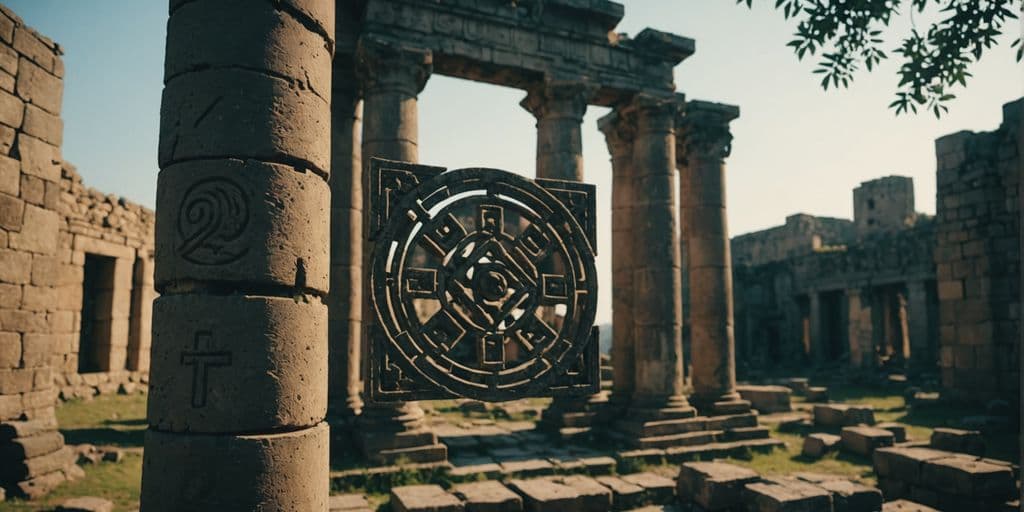Throughout history, many civilizations have vanished, leaving behind only traces of their existence. These ancient mysteries captivate our imagination and challenge our understanding of the past. From the lost city of Atlantis to the enigmatic Voynich Manuscript, these stories of lost civilizations and hidden secrets continue to intrigue and inspire us.
Key Takeaways
- The story of Atlantis, first described by Plato, continues to spark debate about its possible location and existence.
- The Mayan calendar is not only a complex timekeeping system but also a source of various prophecies and predictions.
- El Dorado, the legendary city of gold, has led many explorers on fruitless quests through the South American jungles.
- The Great Pyramid of Giza remains an architectural marvel with many theories about its construction and purpose.
- The Nazca Lines in Peru are giant geoglyphs whose creation and purpose are still not fully understood.
The Enigma of Atlantis
Atlantis is one of the most enduring mysteries of the ancient world. Theories about its location range from the Mediterranean to the Caribbean, and even Antarctica. This theory relies on the notion of shifting continents and ancient maps, like the Piri Reis map, which some claim show Antarctica without ice. Despite numerous expeditions and studies, Atlantis remains elusive, fueling endless speculation and fascination.
The Mysteries of the Mayan Calendar
The Mayan calendar is a complex system that includes several cycles of different lengths. The most famous of these is the Long Count calendar, which spans over 5,000 years. This calendar ends on December 21, 2012, leading many to believe that this marked the end of the world as we know it. However, scholars argue that it simply marked the end of one cycle and the beginning of another.
The Mayan calendar has been the subject of many predictions and prophecies. Some people believed that the end of the Long Count calendar would bring about significant changes or even catastrophic events. Despite these beliefs, no major events occurred on December 21, 2012. Instead, many see it as a time of renewal and transformation.
Archaeologists have made many discoveries that help us understand the Mayan calendar better. These include ancient inscriptions and artifacts that provide insights into how the Mayans tracked time and made predictions. Recent discoveries continue to shed light on this fascinating aspect of Mayan culture.
The Lost City of El Dorado
Legends of El Dorado
The legend of El Dorado has fascinated explorers and treasure hunters for centuries. It tells of a city made entirely of gold, hidden deep within the South American jungle. The story began with tales from indigenous tribes, who spoke of a king who would cover himself in gold dust and dive into a sacred lake. This ritual gave rise to the myth of a golden city, sparking numerous expeditions.
Expeditions in Search of El Dorado
Many expeditions set out to find El Dorado, driven by the promise of unimaginable wealth. Spanish conquistadors, including Gonzalo Pizarro and Francisco de Orellana, ventured into the Amazon rainforest in the 16th century. Their journeys were fraught with danger, from treacherous terrain to hostile encounters with native tribes. Despite their efforts, El Dorado remained elusive, and many explorers perished in their quest.
Modern Perspectives
Today, the search for El Dorado is viewed through a more critical lens. Historians and archaeologists suggest that the legend may have been a misunderstanding or exaggeration of indigenous customs and wealth. Modern research focuses on uncovering the cultural and historical contexts behind the myth. While the city of gold may never be found, the story of El Dorado continues to captivate the imagination, symbolizing the eternal human quest for discovery and adventure.
The legend of El Dorado, packed with breathtaking suspense and nerve-shredding action, remains a thrilling tale for all fans of action, suspense, and intrigue.
The Secrets of the Great Pyramid of Giza
Construction Techniques
The construction of the Great Pyramid of Giza has puzzled experts for centuries. Scientists believe they may have solved the mystery of how these massive structures were built over 4,000 years ago. A team from the University of North Carolina Wilmington suggests that the pyramids were likely constructed along a long-lost, ancient river. This would have allowed workers to transport the enormous stones more easily.
Purpose and Function
The exact purpose of the Great Pyramid remains a topic of debate. While it is widely accepted that it served as a tomb for Pharaoh Khufu, some theories propose other functions. These include astronomical observatories or even energy generators. The pyramid’s alignment with the stars and its precise measurements continue to intrigue researchers.
Recent Discoveries
Recent technological advancements have led to new discoveries about the Great Pyramid. For instance, scientists have used muon radiography to uncover hidden chambers within the structure. These findings suggest that there is still much to learn about this ancient wonder. The ongoing research keeps the mystery of the Great Pyramid alive, captivating the imagination of people around the world.
The Nazca Lines of Peru
Theories Behind the Nazca Lines
The Nazca Lines are a series of enormous drawings etched into the dry coastal plain of Peru. These geoglyphs, created by a pre-Inca civilization around 2,000 years ago, remained largely unknown until aircraft began flying over the area in the 1930s. To date, over 1,000 designs have been discovered. Most are straight lines stretching up to 30 miles, while others depict animals and plants, including a spider, a hummingbird, and a monkey. Researchers still debate their purpose, with one prominent theory associating them with water rituals.
Methods of Creation
Creating the Nazca Lines was no small feat. The ancient people removed the reddish-brown iron oxide-coated pebbles that cover the surface of the Nazca desert, revealing the light-colored earth beneath. This method created the contrast needed for the lines to be visible from a distance. The precision of these large line drawings suggests that the Nazca people had a sophisticated understanding of geometry and surveying techniques.
Recent Studies
Recent studies have continued to uncover new geoglyphs and provide insights into their creation and purpose. As recently as 2022, 168 new geoglyphs were discovered. Advances in technology, such as satellite imagery and drones, have allowed researchers to study the lines in greater detail. These studies have reinforced the idea that the lines were part of a complex cultural and religious landscape, possibly related to astronomical events or agricultural cycles.
The Voynich Manuscript
History of the Manuscript
The Voynich Manuscript is a mysterious book that has puzzled experts for years. It was discovered in 1912 by a rare book dealer named Wilfrid Voynich. The manuscript is written in an unknown language or code, and it contains strange illustrations of plants and naked women. No one has been able to decipher it, not even famous codebreakers like Alan Turing or the FBI. Some people think it might be an elaborate hoax, but its true origin remains a mystery.
Attempts at Deciphering
Many have tried to crack the code of the Voynich Manuscript. Over the years, several people have claimed to have solved it, but their solutions have been met with skepticism. The manuscript is now housed at Yale University, where it is available for anyone who wants to take a shot at solving this ancient puzzle.
Current Theories
There are many theories about what the Voynich Manuscript could be. Some believe it is a medical text, while others think it might be a book of magic or a secret code. Despite numerous attempts, the manuscript’s true purpose and meaning remain unknown. The book includes chapters of historical notes, background, and theories, but otherwise is a faithful page-by-page full-scale reproduction of the original.
The Stone Spheres of Costa Rica
The stone spheres of Costa Rica stand as a timeless reminder of the mysteries that lie hidden within our past, waiting to be discovered and deciphered. These nearly perfect spheres, ranging in size from a few centimeters to over two meters in diameter, were first discovered in the 1930s by workers clearing land for a banana plantation. Their purpose and origin remain a subject of debate among archaeologists and historians.
The Knights Templar and Their Hidden Treasures
The Knights Templar began as a small group of knights in the early 12th century. They were initially tasked with protecting Christian pilgrims traveling to the Holy Land. Over time, they grew in power and wealth, becoming one of the most influential military orders of the medieval period. Their military strength enabled them to safely collect, store, and transport bullion to and from Europe and the Holy Land.
Many legends surround the Knights Templar and their supposed hidden treasures. Some believe they discovered and hid the Holy Grail, the Ark of the Covenant, and other religious artifacts. These treasures are thought to be hidden in various secret locations, from underground vaults to remote castles.
Modern investigations into the Templars’ hidden treasures have used advanced technology and historical research. Despite numerous expeditions and studies, the true extent and location of their treasures remain a mystery. Some researchers argue that the treasures may never have existed, while others continue to search, driven by the allure of uncovering ancient secrets.
The mystery of the Knights Templar’s hidden treasures continues to captivate historians and treasure hunters alike, blending history with legend in a quest that spans centuries.
The Green Children of Woolpit
The tale of the Green Children of Woolpit is a pesky medieval mystery that has not been solved. In the 12th century, two children with green skin appeared in the village of Woolpit, England. They spoke an unknown language and wore strange clothes. The villagers took them in, and over time, the children learned English. The boy became sick and died, but the girl survived and eventually lost her green color.
There are many theories about the origin of the Green Children. Some believe they came from an underground world, while others think they were aliens. Another theory suggests they were Flemish immigrants who had been orphaned and were suffering from malnutrition, which caused their greenish skin.
The story of the Green Children has inspired many books, plays, and even movies. It remains a popular legend in England and continues to fascinate people around the world. The mystery of their origin and the strange circumstances of their appearance keep the legend alive.
The Antikythera Mechanism
The Antikythera Mechanism is an ancient Greek hand-powered orrery, often described as the oldest known example of an analogue computer. Discovered in 1901 in the Antikythera shipwreck off the coast of Greece, this intricate device has fascinated historians and scientists alike. It dates back to around 100 BCE and was used to predict astronomical positions and eclipses for calendrical and astrological purposes.
The mechanism’s discovery has significantly altered our understanding of ancient Greek technology, showcasing their advanced engineering skills.
The device consists of a complex system of gears and dials, which were used to track the cycles of the Solar System. It could predict the positions of the Sun, Moon, and possibly the planets. The front dial displayed the Greek zodiac and an Egyptian calendar, while the back dials tracked lunar and solar cycles, including eclipses.
Key Features:
- Front Dial: Displays the Greek zodiac and Egyptian calendar.
- Back Dials: Track lunar and solar cycles, including eclipses.
- Gears: Complex system enabling precise astronomical predictions.
Modern scientists and engineers have created several replicas of the Antikythera Mechanism to understand its function better. These replicas have confirmed that the device was incredibly accurate in its predictions. The study of these replicas has provided valuable insights into the technological capabilities of ancient civilizations.
The Antikythera Mechanism remains a testament to the ingenuity of ancient Greek engineers, bridging the gap between ancient and modern technology.
The Mystery of Stonehenge
Construction and Architecture
Stonehenge, one of the world’s most iconic prehistoric landmarks, has puzzled researchers for centuries. Archaeologists believe that Stonehenge was constructed in several phases from around 3100 BC to 1600 BC. The circle of large sarsen stones, which are the most recognizable part of the structure, was placed between 2600 BC and 2400 BC. The construction techniques used to transport and erect these massive stones remain a topic of debate. Some theories suggest the use of wooden sledges and rollers, while others propose more complex methods involving ropes and manpower.
Theories of Purpose
The purpose of Stonehenge has been the subject of much speculation. While most researchers agree it functioned as a burial site, its other roles are still debated. Some theories propose that Stonehenge was used for religious or ceremonial purposes, while others suggest it had astronomical significance. The alignment of the stones with the solstices supports the idea that it may have been used as an ancient calendar. Another theory is that Stonehenge had therapeutic properties, possibly serving as a place of healing.
Recent Archaeological Findings
Recent studies have provided new insights into the mysteries of Stonehenge. Advanced technologies like ground-penetrating radar and 3D scanning have revealed hidden features beneath the surface, including pits and ditches that may have been part of the site’s original design. These discoveries have led to new theories about the site’s construction and use. Despite these advancements, many questions about Stonehenge remain unanswered, keeping its mystery alive for future generations.
The Legend of the Lost City of Z
Explorations and Expeditions
The search for the Lost City of Z has captivated explorers for centuries. The most famous expedition was led by British explorer Percy Fawcett in the early 20th century. Fawcett believed that deep within the Amazon rainforest lay a grand mystery reaching back centuries, a city of immense wealth and advanced civilization. Despite numerous attempts, Fawcett and his team vanished without a trace, adding to the legend’s allure.
Theories and Speculations
Many theories have emerged about the true nature of the Lost City of Z. Some suggest it was an ancient civilization with advanced knowledge and technology, while others believe it to be a myth born from the imaginations of explorers. The sensational disappearance of Fawcett made headlines around the world, fueling speculation and intrigue. Modern archaeologists continue to debate the existence of such a city, with some recent discoveries hinting at the possibility of advanced ancient societies in the Amazon.
Modern Discoveries
In recent years, technology has played a crucial role in the search for the Lost City of Z. Lidar technology has revealed hidden structures beneath the dense jungle canopy, suggesting that large, complex societies once thrived in the region. These findings have led to renewed interest and further expeditions, as researchers hope to uncover the truth behind the legend. The quest for truth that leads to death and mystery continues to inspire adventurers and scientists alike.
Conclusion
The mysteries of ancient civilizations continue to captivate our imaginations. From the towering pyramids of Egypt to the enigmatic Stonehenge, these ancient wonders remind us of the ingenuity and creativity of our ancestors. While many questions remain unanswered, each discovery brings us closer to understanding the lives and cultures of those who came before us. As we continue to explore and uncover the secrets of the past, we gain a deeper appreciation for the rich tapestry of human history. The journey to uncover these ancient mysteries is ongoing, and who knows what incredible discoveries await us in the future?
Frequently Asked Questions
What is the mystery of Atlantis?
Atlantis is a legendary island mentioned by Plato. Some believe it was a real place that sank into the ocean, while others think it’s purely myth. Various theories place it in different locations, but its existence remains unproven.
How does the Mayan calendar work?
The Mayan calendar is a system of calendars used by the ancient Maya civilization. It includes the Tzolk’in (a 260-day calendar) and the Haab’ (a 365-day calendar). These calendars work together to form a longer cycle called the Calendar Round.
What is El Dorado?
El Dorado is a mythical city of gold that explorers searched for in South America. The legend began with tales of a king covered in gold dust who would dive into a lake. Despite many expeditions, no one has ever found this city.
How were the Great Pyramids of Giza built?
The construction techniques of the Great Pyramids of Giza are still debated. It’s believed they were built using large limestone blocks transported from nearby quarries. Workers likely used ramps and levers to move and position the stones.
What are the Nazca Lines?
The Nazca Lines are large geoglyphs etched into the desert floor in Peru. They depict various shapes, animals, and plants. Their purpose is unknown, but theories include astronomical markers and religious rituals.
What is the Voynich Manuscript?
The Voynich Manuscript is an illustrated codex written in an unknown script. Discovered in 1912, it has puzzled scholars for years. Despite numerous attempts, no one has deciphered its language or understood its purpose.
Why were the stone spheres of Costa Rica made?
The stone spheres of Costa Rica, also known as Diquís Spheres, are large, perfectly round stones. Their purpose is unknown, but they may have been used as status symbols or markers. They date back to the Diquís culture around 600-1000 AD.
What is the Antikythera Mechanism?
The Antikythera Mechanism is an ancient Greek device used to predict astronomical positions and eclipses. Discovered in a shipwreck, it dates back to around 100 BC. It is considered one of the earliest known analog computers.




